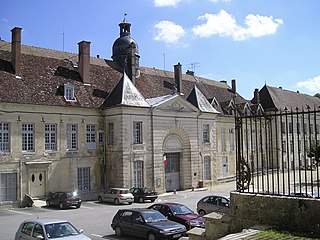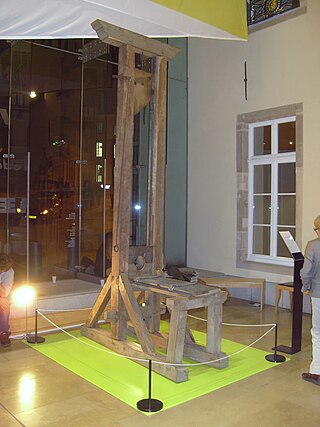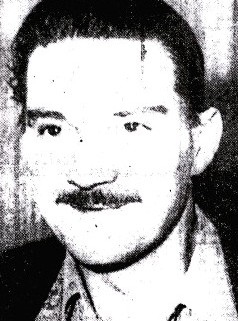
Clairvaux Prison is a high-security prison in France, on the grounds of the former Clairvaux Abbey

Clairvaux Prison is a high-security prison in France, on the grounds of the former Clairvaux Abbey
Clairvaux Abbey was founded in 1115 by Bernard of Clairvaux. During the French Revolution, it became property of the State. In 1808, Napoleon turned it into a prison. [1] A good part of the abbey's manuscripts are now in the Médiatéque du Grand Troyes (Grand Troyes Media Library).
The initial prisoners were rebellious soldiers. After the collapse of the Paris Commune in 1871, a number of Communards were held there. Revolutionary Louis Auguste Blanqui spent some time in solitary. It became the largest French penitentiary of the 19th century. [2] Communist militant Guy Môquet was imprisoned there by the Vichy government. [3]
In 1971, two convicts, Claude Buffet and Roger Bontems, took as hostages a nurse, Nicole Comte, and a prison guard, Guy Girardot. Buffet subsequently murdered them. Buffet and Bontems were captured. Bontems, whose defence counsel included Robert Badinter, contended that the murder was Buffet's idea. Buffet said that he wanted death. Both were sentenced to death by the assize court in June 1972 and were guillotined. [4]
On 16 January 2006, several detainees who were serving life sentences in Clairvaux Prison, having each spent from 6 to 28 years in prison, signed a manifesto denouncing the "false" abolition of the death penalty. They declared that it had resulted in a slow and continuous punishment, a death in life. They called for restoration of the death penalty.
The convicts specifically denounced the French Republic which claimed, in accordance with the "advises of the European Council", that the "enforcing of prison sentences... has been conceived not only to protect society and assure the punishment of the convict, but also to favour his amendment and prepare his rehabilitation". They stated, "In reality: everything is for the punishment." [5]
As of 2022, there were forty prisoners held at the facility, but by September 2023 they are expected to be transferred to another prison. [2]

Clairvaux Abbey was a Cistercian monastery in Ville-sous-la-Ferté, 15 kilometres (9.3 mi) from Bar-sur-Aube. The original building, founded in 1115 by St. Bernard, is now in ruins; the present structure dates from 1708. Clairvaux Abbey was a good example of the general layout of a Cistercian monastery. The abbey has been listed since 1926 as a historical monument by the French Ministry of Culture.

A guillotine is an apparatus designed for efficiently carrying out executions by beheading. The device consists of a tall, upright frame with a weighted and angled blade suspended at the top. The condemned person is secured with a pillory at the bottom of the frame, holding the position of the neck directly below the blade. The blade is then released, swiftly and forcefully decapitating the victim with a single, clean pass; the head falls into a basket or other receptacle below.

Aube is a French department in the Grand Est region of north-eastern France. As with sixty departments in France, this department is named after a river: the Aube. With 310,242 inhabitants (2019), Aube is the 74th department in terms of population. The inhabitants of the department are known as Aubois or Auboises.

The penal colony of Cayenne, commonly known as Devil's Island, was a French penal colony that operated for 100 years, from 1852 to 1952, and officially closed in 1953, in the Salvation Islands of French Guiana.

Hamida Djandoubi was a Tunisian convicted murderer sentenced to death in France. He moved to Marseille in 1968, and six years later he kidnapped, tortured, and murdered 22-year-old Élisabeth Bousquet. He was sentenced to death in February 1977 and executed by guillotine in September that year. He was the last person to be executed in Western Europe, and also the last person to be lawfully executed by beheading anywhere in the Western world, although he was not the last person sentenced to death in France. Marcel Chevalier served as chief executioner.
Robert Badinter is a French lawyer, politician and author who enacted the abolition of the death penalty in France in 1981, while serving as Minister of Justice under François Mitterrand. He has also served in high-level appointed positions with national and international bodies working for justice and the rule of law.

La Santé Prison is a prison operated by the French Prison Service of the Ministry of Justice located in the east of the Montparnasse district of the 14th arrondissement in southern Paris, France at 42 Rue de la Santé. It is one of the most famous prisons in France, with both VIP and maximum security sections.

Papillon is a novel written by Henri Charrière, first published in France on 30 April 1969. Papillon is Charrière's nickname. The novel details Papillon's purported incarceration and subsequent escape from the French penal colony of French Guiana, and covers a 14-year period between 1931 and 1945.

Hugh was the Count of Champagne from 1093 until his death.
"Claude Gueux" is a short story written by Victor Hugo in 1834. It is considered an early example of "true crime" fiction, and contains Hugo's early thoughts on societal injustice which thirty years later he would flesh out in his novel Les Misérables. Charles Carlier, merchant, and editor of the Revue de Paris considered the work to be of such great educational value that he arranged for copies to be sent to all the deputies in France.

Capital punishment in France is banned by Article 66-1 of the Constitution of the French Republic, voted as a constitutional amendment by the Congress of the French Parliament on 19 February 2007 and simply stating "No one can be sentenced to the death penalty". The death penalty was already declared illegal on 9 October 1981 when President François Mitterrand signed a law prohibiting the judicial system from using it and commuting the sentences of the seven people on death row to life imprisonment. The last execution took place by guillotine, being the main legal method since the French Revolution; Hamida Djandoubi, a Tunisian citizen convicted of torture and murder on French soil, who was put to death in September 1977 in Marseille.

André Obrecht was the official executioner of France from 1951 until 1976.

Capital punishment is forbidden by the Charter of Fundamental Rights and Freedoms of the Czech Republic and is simultaneously prohibited by international legal obligations arising from the Czech Republic's membership in both the Council of Europe and the European Union.

The Diocese of Troyes is a Latin Church ecclesiastical territory or diocese of the Catholic Church in Troyes, France. The diocese now comprises the département of Aube. Erected in the 4th century, the diocese is currently a suffragan diocese in the ecclesiastical province of the metropolitan Archdiocese of Reims. It was re-established in 1802 as a suffragan of the Archbishopric of Paris, when it comprised the départements of Aube and Yonne and its bishop had the titles of Troyes, Auxerre, and Châlons-sur-Marne. In 1822, the See of Châlons was created and the Bishop of Troyes lost that title. When Sens was made an archdiocese, the episcopal title of Auxerre went to it and Troyes lost also the département of Yonne, which became the Archdiocese of Sens. The Diocese of Troyes covers, besides the ancient diocesan limits, 116 parishes of the ancient Diocese of Langres and 20 belonging to the ancient diocese of Sens. On 8 December 2002, the Diocese of Troyes was returned to its ancient metropolitan, the Archbishop of Reims. As of 2014, there was one priest for every 2,710 Catholics.

We Are All Murderers is a 1952 French film written and directed by André Cayatte, a former attorney. It tells the story of René, a young man from the slums, trained by the French Resistance in World War II to kill Germans. He continues to kill long after the war has ended, as it is all he knows.

Jérôme Henri Carrein was the second-to-last convicted criminal to be executed by guillotine in France.
Capital punishment was abolished in Turkey in 2004, and no prisoners have been executed since October 1984. Before, the capital punishment was executed over 500 times. The method of execution was hanging.
Claude Buffet was a French criminal who was executed along with his accomplice, Roger Bontems (1936–1972), on 28 November 1972 by guillotine at La Santé Prison and buried at Ivry Cemetery. Both men had been convicted of the murders of prison warder Guy Girardot and prison nurse Nicole Comte in 1971, whom they had taken hostage while Buffet was already serving a life sentence in Clairvaux Prison. Robert Badinter was their defence lawyer.

The Penal Code of 1810 was a code of criminal law created under Napoleon which replaced the Penal Code of 1791. Among other things, this code reinstated a life imprisonment punishment, as well as branding. These had been abolished in the French Penal Code of 1791. Issued on June 3, 1810, it stayed in use until March 1, 1994 when it was replaced by the Code pénal.
Thierry Lévy was a high-profile French criminal defence lawyer who spent his career in a state of permanent opposition to the French legal establishment. Admitted to the Paris bar in 1969, he went on to appear in a succession of well publicised criminal trials during the ensuing three and a half decades. His father had been a journalist and press proprietor who was not infrequently supportive of nationalist and other right-wing movements. Thierry Lévy's own assessments of the French criminal justice system, which he shared frequently through the print media and, especially during his later years, in television debates, placed him firmly at the liberal-left end of the political spectrum, however. He was a prominent and eloquent backer of the campaign that led to the abolition of the death penalty by Justice Minister Robert Badinter under President Mitterrand in 1981.
In the middle of March, 1883, twenty-two of us, who had been condemned to more than one year of imprisonment, were removed in great secrecy to the central prison of Clairvaux.